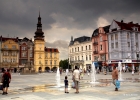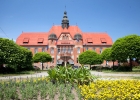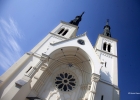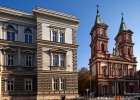

Why come to Ostrava
Would you like to study the Czech or English language, attend a preparatory course for entrance examinations and not get bored in your leisure time? Come to our school in Ostrava — a fast-growing megalopolis. Ostrava is not only the popular Stodolni Street with its bars and clubs. Ostrava is a city for young people and the main city in the Moravian-Silesian region.
Do you have any doubts? Then have a look at these photos! Ostrava residents truly love their city with all their hearts. Ostrava has become a city of multiple colours and shades. Ostravians say that before the end of mining in 1991, there had been 33 functioning pile drivers. Nowadays Ostrava doesn’t have any active mines, and the pile drivers which survived the downturn have become cultural sites. Consequently, the city gradually awoke from its black sleep — although mining traditions are preserved, the air has become a lot cleaner, the amount of greenery per capita has become several times higher than other large cities, and industry has gradually shifted from heavy to average.
Now it’s time to find out where “the most and the best” things are located in Ostrava.
Ostrava town hall which has the highest observation town hall tower (72 meters). Stodolni Street (Stodolní) – a street which never sleeps. This street has the highest number of bars and pubs located at the same place. Landek museum is the biggest mining museum, which boasts the largest collection of mining rescue equipment. The oldest pedestrian zone in the Czech Republic. Other “most and best” things in Ostrava include the oldest documented use of black coal, the deepest coal mine, and the biggest industrial monument.
The longest spa water supply runs from Ostrava-Polanka. The Ostrava museum proudly houses the most original indoor astronomical clock. In Ostrava Poruba you can see the biggest natural swimming-pool in the Czech Republic. Ostrava sports hall (CEZ Arena) has the biggest playing area among all the sports facilities in the Czech Republic. The Puppet Theatre is fittingly proud of being the most modern among all the puppet theatres in the Czech Republic. The biggest subsidiary of Librex bookshop is also situated in Ostrava. Here you can also find the biggest boulder of the Black Meadow (Cerna Louka), which travelled from Scandinavia to Ostrava. The largest Judaica is situated in the Ostrava central cemetery. In the Janacek conservatory you can listen to the most modern organ in the Czech Republic.
Do you like festivals?
Ostrava is famous for its international musical festival “Colours of Ostrava”, in which around 100 hundred musical bands from all over the world take part every year. If you prefer classical music, do not miss Janacek May and Janacek Hukvaldy International Music Festival. Puppets lovers and puppet theatre goers will enjoy attending meetings of actors from all over the world, which take place on a regular basis in Ostrava and are known as Biennale Spectaculo Interesse Ostrava. Young people who like to shoot films can take part in a famous festival of children and students of film art called “Ostravský koníček”. There are plenty of other festivals as well, such as the festival of four Ostrava drama theatres “Ostravar”, Saint Vatslav musical festival, “New music festival”, and “Folklore without borders”. Other festivals include dance festivals, festivals of culinary art, wine, travel, sports and so on.
And where should you go for a walk? The Silesian Ostrava Castle is situated a stone’s throw away from the city centre and is an ideal place for this. You can also take a very enjoyable and entertaining stroll in the big Zoo, or in the museum of miniatures “Miniuni” – an open air museum where you will find miniature copies of famous European architectural sites. Or you can visit Dinopark, which will surprise you with its dinosaurs! Not far from the miniature museum you will see “The Fairytale Ghost Cellar”. There are several cinemas in Ostrava – “Multikino CineStar”, “Kino Luna”, “Minicinema-coffee room”, “Kino Art”, academic cinematic club “Vesmir” and “Kino Polanka”. After taking a walk or watching a film, you can drop in at a bar or a pub and have some delicious Czech beer.
If nothing from the above list is of interest to you, pay attention to the theatres! In addition to the above mentioned Puppet Theatre, you can visit the National Slesian Moravian Theatre, the Petr Bezruc Theatre, or the youngest and smallest chamber theatre in the Czech Republic “Arena”. Avid art lovers will enjoy 40 Ostrava galleries.
Do you like museums? Ostrava offers you 3 – the “Firemen museum”, the “Mining museum OKD” and the “Ostrava City Museum”. Are you more interested in technology? Then you will definitely like Ostrava! Only in Ostrava will you be able to see the national cultural site “Hlubin Mine” (Důl Hlubina), blast furnaces, the Vitkovice Steel Plant and the pile driver mine Důl Jindřich.
If you still haven’t found what you’re looking for, Ostrava offers you several superb types of beer, produced at the local brewery “Ostravar”.
The city is an important thoroughfare – it is very easily accessible by car, rail and air, and has a perfect transport connection with other Czech cities and other European countries. There are several railway stations, bus stations, and an airport. There are also cyclist routes and lanes.
And what about sports? Ostrava has its own football team “FC Baník Ostrava” and its hockey team ”HC Vítkovice Steel, a.s.”. In Ostrava you will find a whole range of stadiums, sports pitches, courts and swimming pools. You can even play golf, or ride a horse. Enthusiasts of winter sports, summer hiking, and mountain biking can enjoy the Beskydy mountains, located 30 minutes by car from the city. At the City Stadium in Ostrava Vitkovice, an annual athletes meeting takes place, where you can meet the biggest stars of the modern track and field world.
Not far from Ostrava are several famous Polish and Slovak cities – Wroclaw, Katowice, Opole, Oswiecim, Zilina, Cadca and Krakow. Krakow is the main centre of Polish culture and is visited by approximately 4 million tourists every year. It is also the second largest city in Poland. The old part of Krakow, with its historic buildings, has been on the UN cultural heritage site list since 1978.














































